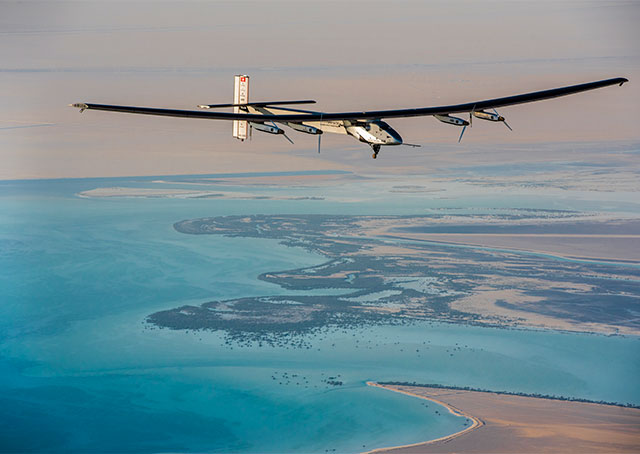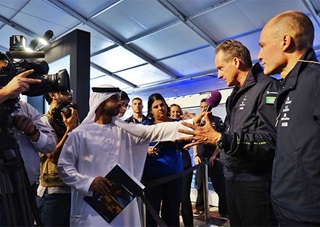
With the world watching live online, Swiss pilot André Borschberg launched Solar Impulse 2 on a journey into history March 9, departing from Abu Dhabi in the United Arab Emirates and landing, nearly 14 hours later, in Muscat, Oman. This first leg of a planned five-month circumnavigation on zero fuel was 215 nautical miles long, direct, though the flight was far from direct: Borschberg was still loitering over the Gulf of Oman 12 hours after launch, waiting for an opening in the air traffic into Muscat.
The lightweight, solar-powered single-seater with the wingspan of a Boeing 747 taxied to parking 13 hours and 46 minutes after launch, according to real-time telemetry transmitted worldwide online. Mission planners had expected ATC delays into Muscat, and their expectation proved correct.
Flight data including airspeed and groundspeed, attitude, and other telemetry appeared to generate significant interest, and the enthusiasm apparently ran too high for the Solar Impulse servers to handle. The website established by the Solar Impulse team experienced sporadic outages and inconsistent display of real-time telemetry while the flight was in progress.

The team had planned a 12-hour flight that was 12 years in the making. Bertrand Piccard, the Swiss pilot and adventurer who will alternate legs with Borschberg, and Borschberg launched the Solar Impulse program in 2003 following a feasibility study. The first prototype of the solar-powered airplane was unveiled in 2009, and made its first intercontinental flight in 2012. The team toured the United States in 2013, breaking three distance records in the process. Si2, the aircraft now embarked on the round-the-world journey, is an updated version of that aircraft, and made its maiden flight in 2014.
"We are very ambitious in our goal, but modest given the magnitude of the challenge,” the pilots said in a March 9 news release. “This is an attempt, and only time will tell if we can overcome the numerous weather, technical, human and administrative issues.”
The pair will split 500 hours of flight time and spend an estimated total of 25 days of flying, spread over the coming five months, including one leg over the Pacific that could stretch to six days. Three of the 12 planned stops are in the U.S., including Hawaii, Phoenix, and New York. The pilots will use meditation to help them stay sharp and focused during the extreme endurance legs to come, dining on specially prepared meals engineered to give them the required nutrition.



